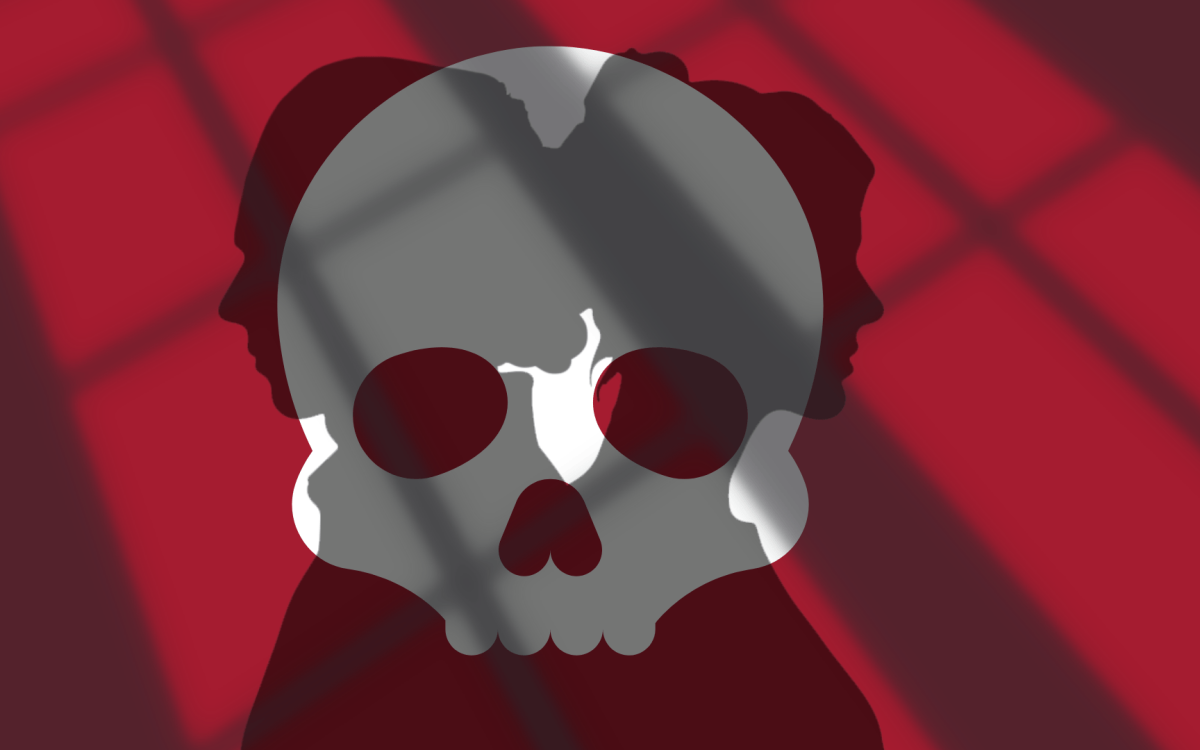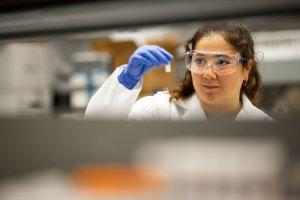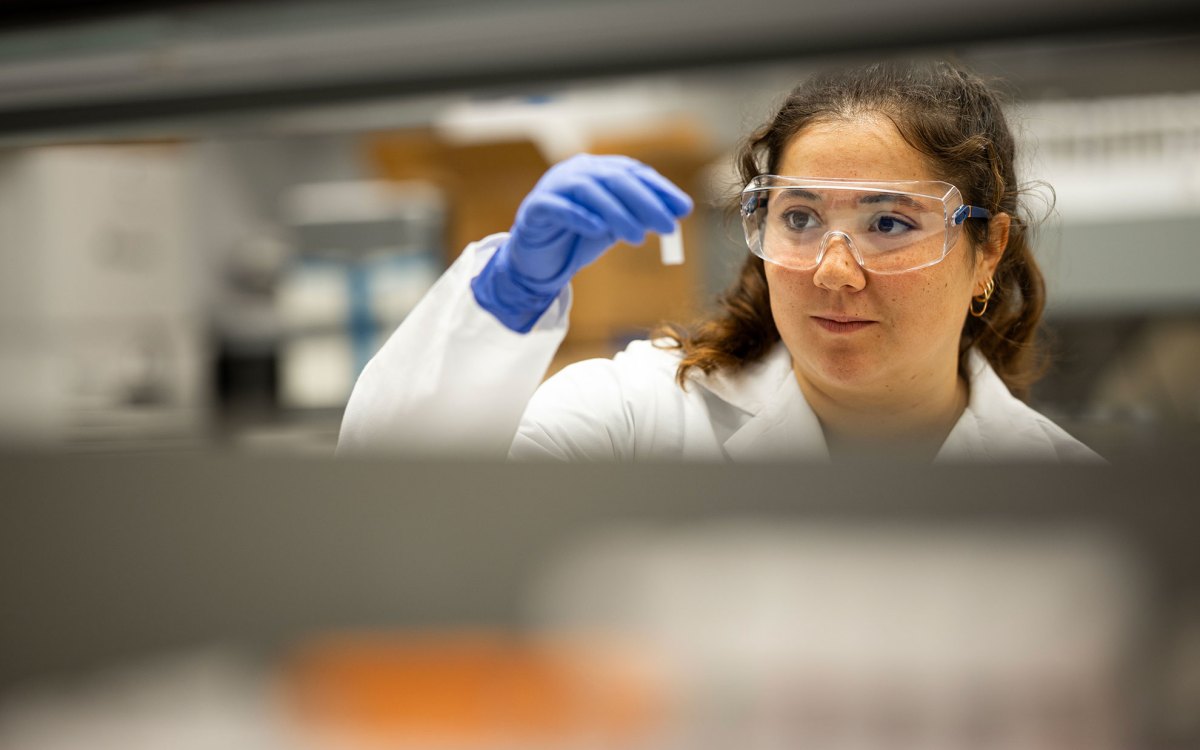Chemist, card shark Liu takes off
In lab, Liu uses DNA to guide synthesis of chemical compounds
In some corners of Las Vegas, Harvard chemist David Liu is viewed as a dangerous man.
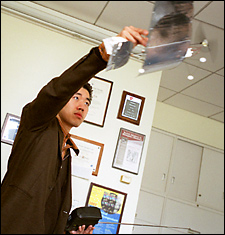
Liu, 31, is a skilled blackjack player – too skilled, in the eyes of the MGM Grand family of casinos. Two years ago, he was barred from all MGM Grand facilities after winning too much money playing thousands of hands at the blackjack table.
“I was just trying to earn enough to buy my wife a certain pair of earrings,” explains the recently tenured professor of chemistry and chemical biology.
The card-shark chemist took up blackjack with a passion as a Harvard College undergraduate, delving into the mathematics of blackjack, writing computer programs, and even teaching a course in Currier House on the game.
“You need to play blackjack, essentially, like a robot, with an attention to quick but simple math,” Liu says. “You can never win more hands than you lose in the long run, but you win money by betting more when you are more likely to win.”
Outside the lab, where his research uses DNA to guide synthesis of chemical compounds, Liu says he’s always maintained – and avidly pursued – one or two hobbies in his spare time. After MGM clamped down on his blackjack fun, he turned his attention to radio-controlled airplanes.
“I remember reading, when I was a kid, about this goal among hobbyists to design a plane that would fly so slowly that you could pilot it around inside a living room,” Liu says. “I was surprised to learn, years later, that this goal remained largely unmet.”
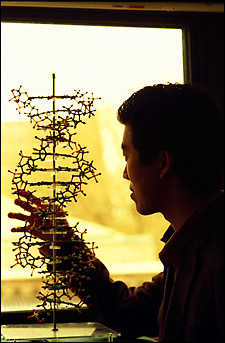
Liu focused his energies on the task, working the lift equations for a vessel in flight and determining how exceptionally light a plane would have to be to remain aloft at superslow speeds. The result was The Wisp, a plane whose carbon fiber technology and lithium batteries weigh in at just 6 grams, the equivalent of six paper clips. Liu has since built a small fleet of the small aircraft, ranging in size from 6 to 15 inches, which can maneuver around a small room at a pokey 1 to 2 mph.
“At that speed and mass, even if the plane crashes into your forehead – which has happened to me numerous times – it doesn’t hurt,” says Liu, whose work for a time was featured in more aviation magazines than chemistry journals.
Liu’s off-the-job tinkering has revived his childhood interest not only in model airplanes, but also in LEGOs. By combining the plastic bricks with a heat sensor from a burglar alarm, Liu recently cobbled together a device that launches toy mice at his two Birman cats. Dubbed a “mouseapult” (as opposed to a catapult) by Liu and his wife Julie, the device sits on the floor in the middle of a room, rotating around in search of a warm body. When it spots a moving heat source, the mouseapult hurls a fur mouse toy from its magazine in the direction of the heat source.
A native of southern California, Liu’s interest in science took root as a child, when he foraged among the bugs and weeds of his suburban back yard. He later moved from amateur botany and entomology to chemistry, mixing household compounds in an attempt “to blow stuff up.” The combination of baking soda and vinegar was always a volatile favorite, he recalls.
“I believe most kids are intrinsically interested in science, driven by curiosity about the world around us,” Liu says. “I was doing experiments without realizing I was doing experiments. I was interested in chemistry before I knew what chemistry was.”
Although he grew up in a household steeped in science – his father is an aerospace engineer and his mother is a retired physics professor – Liu says his parents never pushed him or his sister, now a physician, to pursue careers in science. However, Liu’s interest in science continued to percolate during his teen years, culminating in a second-place finish in the 1990 Westinghouse National Science Talent Search.
Later that year, as a Harvard freshman, Liu thought he’d pursue a degree in physics – a hope that was rather quickly dashed, he notes, by the realization that he was “not very good in physics.” His passion for chemistry was soon kindled in organic chemistry courses taught by Stuart Schreiber and Gregory Verdine, still on the Harvard faculty, and Joseph Grabowski, now at the University of Pittsburgh. Grabowski helped Liu secure a research position in the laboratory of E.J. Corey, now professor emeritus of chemistry and chemical biology, where Liu studied 2,3-oxidosqualene cyclase, a key enzyme in steroid biosynthesis. (Coincidentally, Liu had seen Corey receive the Nobel Prize as one of five American students selected to attend the 1990 Nobel ceremony in Stockholm.)
“My undergraduate work was a mixture of synthetic chemistry and biochemistry,” Liu says. “While I wasn’t sure then what flavor of chemistry I would end up pursuing long term, I was intrigued by this combination, and still find it fascinating today.”
After graduating ranked first in Harvard College’s 1,641-member Class of 1994, Liu left for the University of California, Berkeley, to pursue a Ph.D. in organic chemistry. It was at Berkeley that he met his wife, Julie, now a medicinal chemist working for a pharmaceutical firm. The couple moved back east in 1999, when Liu completed his Ph.D. and was appointed assistant professor at Harvard.
Recognizing that evolution has created far more efficient ways of synthesizing and identifying active molecules than has been accomplished in laboratories, Liu’s current research is guided by the belief that scientists can gain important insights into chemistry and biology through nature’s synthetic ingenuity. His work, recently recognized by his being named a Howard Hughes Medical Institute Investigator, uses biomolecules such as DNA, and the natural tendency of DNA’s component nucleotides to selectively attach to one another, to guide the chemical synthesis of organic compounds. He has found this DNA-templated organic synthesis to be surprisingly general, capable of directing a range of chemistries, and a promising window into chemical reactions and the machinery of life.
